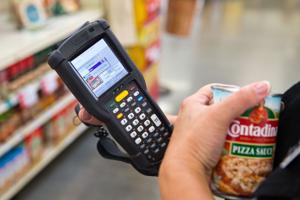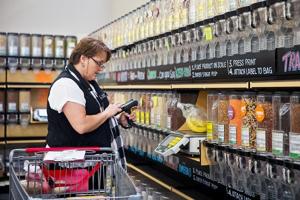Catering to customers, Hy-Vee tests out online grocery service
POSTED: WEDNESDAY, JULY 22, 2015 12:30 AM | UPDATED: 12:02 PM, WED JUL 22, 2015.
When Meera Samtani moved to Omaha this summer from tech hub Palo Alto, California, she worried about how she’d get along without Google Express. The service let her shop online for groceries that were delivered the same day.
With a 2-year-old boy and a baby girl, she found that trips to the grocery store took extra planning and patience, she said.
So Samtani was thrilled when, two weeks ago, supermarket operator Hy-Vee launched a new online grocery service in its Nebraska and Council Bluffs stores. Customers using the service can order ahead and pick up groceries in the store, or have them delivered to their homes or offices.
Now, Samtani just pulls up to the Hy-Vee at 180th and Pacific Streets to pick up her groceries. She doesn’t even have to get out of the car. “It makes a big difference in my life,” she said.
Shoppers like Samtani are the reason West Des Moines-based Hy-Vee is encouraged. The grocery chain says online sales so far have met expectations. Customers are happy, too, it says.
Some small local markets and private services already provide home delivery of groceries in the Omaha area, but Hy-Vee is the first major retailer to do so.
Hy-Vee isn’t trying to make money on the service itself. The fees — $4.95 for home delivery and $2.95 for store pickup — don’t cover the costs, it says.
Instead, Hy-Vee is trying to retain and gain customers in the face of competition from all corners: convenience, dollar and club stores; other grocery chains that are opening and remodeling stores in Omaha; and online services such as Amazon, which doesn’t offer its Amazon Fresh grocery delivery service here but does provide its Amazon Prime Pantry dry goods shipping service.
Hy-Vee also is trying to pre-empt future competition. Walmart, for instance, has a large grocery presence in Omaha. It’s testing a grocery-delivery service in other markets.
At a time when traditional supermarkets are losing market share across the country, Hy-Vee executives are asking: “How do we reach another customer that we might not currently be reaching?” said Brandon Williams, Hy-Vee’s group vice president for e-commerce.
His is a new position for the employee-owned company that began with one general store in 1930 and now has 235 stores in eight states, and nearly $9 billion in annual sales.
Williams envisions a busy parent ordering groceries online during a child’s soccer game, or over the lunch hour. “We’re just seeing the future, and how people are pressed for time,” he said.
Called Aisles Online, the service launched in Des Moines in April and in Nebraska and Council Bluffs this month. It is coming soon to stores in Kansas City, Illinois, Minnesota and elsewhere in Iowa. All Hy-Vee stores will offer the service, which is accessed by a website — not an app — by fall.
Also read: Where to shop online in Omaha / How do ConAgra and other food companies reach online consumers?
It differs from urban offerings like Fresh Direct and Peapod, which ship items from a centralized distribution center and don’t operate retail stores. It’s also different from Instacart, which lets shoppers order through an app from stores including Whole Foods, Costco, Kroger and Petco, with a personal shopper picking items and delivering them.
With Hy-Vee’s service, each store employs people dedicated to fulfilling and delivering online orders. The store where Samtani shops employs 15 full- and part-time Aisles Online workers, a staffing level based on order patterns at a Hy-Vee in West Des Moines with similar household demographics. The Des Moines store, one of the busiest in the company for online sales, is seeing about 50 orders a day.
Sandy Berven, a former Hy-Vee human resources manager who relocated to the west Omaha store to manage online services there, demonstrated how the service works as she picked and packed an order one recent morning for a west Omaha mother with three children.
The customer’s shopping list showed up on the screen of a hand-held scanner. The scanner, which is tied to a map of the store, listed the items in the order Berven should pick them from the shelves, starting with nonperishable items like shampoo and cereal, then meat and produce, and finally frozen pizzas. This way, cold items stay cold as long as possible.
The scanner prevented Berven from making some errors, like accidentally picking out a 15-ounce can of pizza sauce when the customer ordered an 8-ounce can. But Berven did have to make the kind of judgments a computer can’t.
When there were green grapes on the shelf but not red grapes, she had to flag the produce manager to get some. When there were no Lean Cuisine three-meat pizzas, she had to decide if the customer would prefer the pepperoni, supreme or chicken variety. (Customers can opt to have the store not make any substitutions, in which case an item that’s unavailable would just be dropped from the order.)
When she picked out apples, she studied each one to make sure it had no blemishes. And when she picked out a pack of bacon, she flipped through the rack to find the one that looked to have the most meat.
Choosing the food that goes on a family’s dinner table is “really personal,” Berven said. She will even call the customer to be sure an order is correct if she is unsure about something.
That type of time-consuming selection process might satisfy customers, but it can weigh on the profitability of e-commerce programs, which are “barely profitable,” according to a 2015 study of online grocery business models by Chicago-area research firm Willard Bishop with University of Michigan Ross School of Business professor Amitabh Sinha.
The study said the largest costs associated with providing the services are delivery, store labor and store or warehouse occupancy costs. Larger volumes can bring these costs down, but even if the services aren’t hugely profitable, some retailers view e-commerce as something they must provide to stay relevant with shoppers and keep their business.
Still, this and other studies say, there is significant room to grow. E-commerce accounts for only about 3 percent of an annual $600 billion in sales of grocery and consumer packaged goods sales, Willard Bishop said.
The Grocery Manufacturers Association in a report last year said if brick-and-mortar stores don’t join the online party, they risk shrinking sales as some of their best customers shift more shopping online, and make fewer trips to the store.
“Retailers are scared, with good reason, over the prospect of losing their best customers,” the report said. Shopping volume is up, but trips to traditional stores are declining, it said.
Especially in the grocery business, in which profit margins are slim, retailers can’t afford to forgo online sales, the group said.
How it works
Signing up: Shoppers can log onto Hy-Vee’s website at www.hy-vee.com/grocery.
Cost: The delivery fee is $4.95. For in-store pickup, Hy-Vee charges $2.95. The fees are waived if the order is $100 or more.
What’s there: The site doesn’t mimic an aisle-by-aisle stroll through the grocery store. Instead, shoppers search or scroll through different categories, which include bakery, pantry and frozen foods.
Restrictions: Alcohol and tobacco can’t be ordered for home delivery. They can be ordered online for pickup in the store, where customers must show an ID and sign for the items.
Keeping cool: Groceries are packed into insulated bins. For home delivery, cold water bottles and dry ice keep items cold.
Hours: Same-day home deliveries for noon or later must be ordered by 8 a.m. For deliveries at 5 p.m. or later, there’s a 10 a.m. deadline. Someone must be home to receive the delivery. In-store pickup orders must be ordered by 10 a.m. for pickup at 2 p.m. or later, or by 1 p.m. for pickup by 5 p.m. or later.





No comments:
Post a Comment